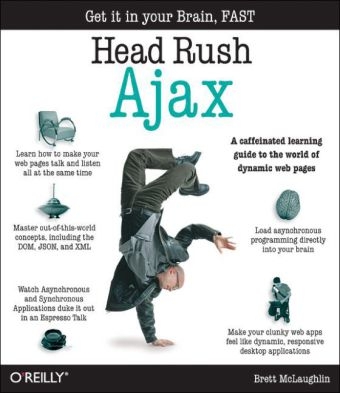
Head Rush Ajax
O'Reilly Media (Verlag)
978-0-596-10225-8 (ISBN)
- Titel ist leider vergriffen;
keine Neuauflage - Artikel merken
Sick of creating web sites that reload every time a user moves the mouse? Tired of servers that wait around to respond to users' requests for movie tickets? It sounds like you need a little (or maybe a lot of) Ajax in your life. Asynchronous programming lets you turn your own websites into smooth, slick, responsive applications that make your users feel like they're back on the information superhighway, not stuck on a dial-up backroad. But who wants to take on next-generation web programming with the last generation's instruction book? You need a learning experience that's as compelling and cutting-edge as the sites you want to design. That's where we come in. With "Head Rush Ajax", in no time you'll be writing JavaScript code that fires off asynchronous requests to web servers...and having fun doing it. By the time you've taken your dynamic HTML, XML, JSON, and DOM skills up a few notches, you'll have solved tons of puzzles, figured out how well snowboards sell in Vail, and even watched a boxing match. Sounds interesting? Then what are you waiting for? Pick up "Head Rush Ajax" and learn Ajax and asynchronous programming the right way - the way that sticks.
If you've ever read a "Head First" book, you know what to expect: a visually rich format designed for the way your brain works. "Head Rush" ramps up the intensity with an even faster look and feel. Have your first working app before you finish Chapter 1, meet up with the nefarious PROJECT: CHAOS stealth team, and even settle the question of the Top 5 Blues CDs of all time. Leave boring, clunky websites behind with 8-tracks and hot pants - and get going with next-generation web programming. "If you thought Ajax was rocket science, this book is for you. "Head Rush Ajax" puts dynamic, compelling experiences within reach for every web developer." - Jesse James Garrett, Adaptive Path. "A 'technology-meets-reality' book for web pioneers on the cutting edge." - Valentin Crettaz, CTO, Condris Technologies.
Elisabeth Freeman is an author, software developer, and digital artist. She's been involved with the internet since the early days, having co-founded The Ada Project (TAP), an award-winning website for women in computing now adopted by the ACM. More recently, Elisabeth led research and development efforts in digital media at the Walt Disney Company, where she co-invented Motion, a content system that delivers terabytes of video every day to Disney, ESPN, and Movies.com users. Elisabeth is a computer scientist at heart and holds graduate degrees in Computer Science from Yale University and Indiana University. She's worked in a variety of areas including visual languages, RSS syndication, and internet systems. She is a coauthor of O'Reilly's Head First Design Patterns. She's also been an active advocate for women in computing, developing programs that encourage woman to enter the field. These days you'll find her sipping some Java or Cocoa on her Mac, although she dreams of a day when the whole world is using Scheme. Elisabeth has loved hiking and the outdoors since her days growing up in Scotland. When she's outdoors her camera is never far. She's also an avid cyclist, vegetarian, and animal lover. Eric Freeman is a computer scientist with a passion for media and software architectures and coauthor of Head First Design Patterns. He just wrapped up four years at a dream job-- directing internet broadband and wireless efforts at Disney--and is now back to writing, creating cool software, and hacking Java and Macs. Eric spent a lot of the '90s working on alternatives to the desktop metaphor with David Gelernter (and they're both still asking the question, "Why do I have to give a file a name?"). Based on this work, Eric landed a Ph.D. at Yale University in 1997. He also co-founded Mirror Worlds Technologies (now acquired) to create a commercial version of his thesis work, Lifestreams. In a previous life, Eric built software for networks and supercomputers. You might know him from such books as JavaSpaces Principles Patterns and Practice. Eric has fond memories of implementing tuple-space systems on Thinking Machine CM-5s and creating some of the first internet information systems for NASA in the late 1980s. When he's not writing text or code you'll find him spending more time tweaking than watching his home theater and trying to restore a circa 1980s Dragon's Lair video game. He also wouldn't mind moonlighting as an electronica DJ. Brett McLaughlin has worked in computers since the Logo days (remember the little triangle?). In recent years, he's become one of the most well-known authors and programmers in the Java and XML communities. He's worked for Nextel Communications, implementing complex enterprise systems, at Lutris Technologies, actually writing application servers, and most recently at O'Reilly Media, Inc., where he continues to write and edit books that matter. His most recent book, Java 1.5 Tiger: A Developer's Notebook, is the first book available on the newest version of Java, and his classic Java and XML remains one of the definitive works on using XML technologies in Java.
| Erscheint lt. Verlag | 2.5.2006 |
|---|---|
| Verlagsort | Sebastopol |
| Sprache | englisch |
| Maße | 178 x 232 mm |
| Einbandart | kartoniert |
| Themenwelt | Informatik ► Web / Internet ► Web Design / Usability |
| ISBN-10 | 0-596-10225-9 / 0596102259 |
| ISBN-13 | 978-0-596-10225-8 / 9780596102258 |
| Zustand | Neuware |
| Haben Sie eine Frage zum Produkt? |
aus dem Bereich


